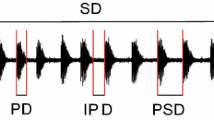Abstract
Many Bruchidae species are quarantine pests and are widely used as model species. However, as far as we know, acoustic communication has never been studied in detail in this group. Below we present the first data on the repertoire and emission mechanisms of acoustic communication in the bean weevil Acanthoscelides obtectus. Three types of signal emission were recorded in A. obtectus: striking the head and abdomen against the substrate, abdominal tremulations, and wing vibrations. Two types of signals were recorded in males, and one type, in females. All the acoustic signals recorded in A. obtectus contained both stable (pulse duration, pulse period: CV = 5–12%) and variable (duration of the pulse series: CV = 50%) signal elements. The frequency parameters showed low variation in all the signals (CV = 5–11%). Moreover, the dominant frequencies were similar in all the signal types (889–1158 Hz).
Similar content being viewed by others
References
Burkholder, W.E. and Yun-Tai, Q.I., “Sex Pheromone and Behavior of the Cowpea Weevil Callosobruchus maculatus,” Journal of Chemical Ecology 8 (2), 527–534 (1982).
Carisio, L., Palestrini, C., and Rolando, A., “Stridulation Variability and Morphology: an Examination in Dung Beetles of the Genus Trypocopris (Coleoptera, Geotrupidae),” Population Ecology 46, 27–37 (2004).
Devereau, A.D., Gudrups, I., Appleby, J.H., and Credland, P.F., “Automatic, Rapid Screening of Seed Resistance in Cowpea, Vigna unguiculata (L.) Walpers, to the Seed Beetle Callosobruchus maculatus (F.) (Coleoptera: Bruchidae) Using Acoustic Monitoring,” Journal of Stored Products Research 39 (1), 117–129 (2003).
Edvardsson, M., Rodriguez-Munoz, R., and Tregenza, T., “No Evidence that Female Bruchid Beetles, Callosobruchus maculatus, Use Remating to Reduce Costs of Inbreeding,” Animal Behaviour 75, 1519–1524 (2008).
Fleming, A.J., Lindeman, A.A., Carroll, A.L., and Yack, J.E., “Acoustics of the Mountain Pine Beetle (Dendroctonus ponderosae) (Curculionidae, Scolytinae): Sonic, Ultrasonic, and Vibration Characteristics,” Canadian Journal of Zoology 91, 235–244 (2013).
Hunt, T., Bergsten, J., Levkanicova, Z., Papadopoulou, A., John, O., et al., “A Comprehensive Phylogeny of Beetles Reveals the Evolutionary Origins of a Superradiation,” Science 318, 1913–1916 (2007).
Kasper, J. and Hirschberger, P., “Stridulation in Aphodius Dung Beetles: Songs and Morphology of Stridulatory Organs in North American Aphodius Species (Scarabaeidae),” Journal of Natural History 39, 91–99 (2005).
Kingsolver, J.M., Romero, N.J., and Johnson, C.D., “Files and Scrapers: Circumstantial Evidence for Stridulation in Three Species of Amblycerus, One New (Coleoptera: Bruchidae),” Pan-Pacific Entomologist 69, 122–132 (1993).
Lextrait, P., Biemont, J.C., and Pouzat, J., “Pheromone Release by Two Forms of Callosobruchus maculatus Females: Effect of Age, Temperature and Host Plant,” Physiological Entomology 20, 309–317 (1995).
Lindeman, A.A. and Yack, J.E., “What’s the Password? Female Red Turpentine Beetles (Dendroctonus valens LeConte) Grant Access to Their Galleries Based on an Assessment of Male Signals,” in 14th Invertebrate Sound and Vibration International Meeting, Glasgow, United Kingdom, July 23–26 (2013), p. 33.
Mano, H. and Toquenaga, Y., “Wall-Making Behavior in Callosobruchus maculatus (Coleoptera: Bruchidae),” Annals of the Entomological Society of America 101 (2), 449–455 (2008).
Njoroge, A.W., Affognon, H., Mutungi, Ch., Richter, U., Hensel, O., et al., “Bioacoustics of Acanthoscelides obtectus (Coleoptera: Chrysomelidae: Bruchinae) on Phaseolus vulgaris (Fabaceae),” Florida Entomologist 100 (1), 109–115 (2017).
Palestrini, C., Pensati, F., Barbero, E., Reyes-Castillo, P., and Zunino, M., “Differences in Distress Signals of Adult Passalid Beetles (Coleoptera Passalidae),” Bollettino della Societa Entomologica Italiana 135, 45–53 (2003).
Ribeiro-Costa, C.S., “Description of Two New Species of Amblycerus Thunberg (Col.: Bruchidae) with a Probable Stridulatory Mechanism,” Proceedings of the Entomological Society of Washington 101, 337–346 (1999).
Riede, K. and Stueben, P.E., “The Musical Acalles, Observations on the Stridulations of Cryptorhynchinae of the Canaries (Col.: Curculionoidea). Cryptorhynchinae Study 13,” in Snudebiller Studies on Taxonomy, Biology and Ecology of Curculionoidea, Vol. 1 (CURCULIO-Institut, Mönchengladbach, 2000), pp. 307–317.
Rup, J., “Mating and Its Attendant Behavior in Callosobruchus maculatus (F) (Coleoptera: Bruchidae),” Journal of Stored Products Research 22 (2), 77–79 (1986).
Sano, I., “Density Effect and Environmental Temperature as the Factors Producing the Active Form of Callosobruchus maculatus (F.) (Coleoptera, Bruchidae),” Journal of Stored Product Research 2, 187–195 (1967).
Šešlija, D., Stojković, B., Tucić, B., and Tucić, N., “Egg-Dumping Behaviour in the Seed Beetle Acanthoscelides obtectus (Coleoptera: Chrysomelidae: Bruchinae) Selected for Early and Late Reproduction,” European Journal of Entomology 106 (4), 557–563 (2009).
Shade, R.E., Furgason, E.S., and Murdock, L.L., “Detection of Hidden Insect Infestations by Feeding-Generated Ultrasonic Signals,” American Entomologist 36 (3), 231–235 (1990).
Shestakov, L.S., “Studies of Vibratory Signals in Pentatomid Bugs (Heteroptera, Asopinae) from European Russia,” Entomological Review 88 (1), 20–25 (2008).
Shestakov, L.S., “A Comparative Analysis of Vibrational Signals in 16 Sympatric Bug Species (Pentatomidae, Heteroptera),” Entomological Review 95 (3), 310–325 (2015).
Stillwell, R.C. and Fox, C.W., “Environmental Effects on Sexual Size Dimorphism of a Seed-Feeding Beetle,” Oecologia 153, 273–280 (2007).
Stojković, B., Jovanović, D.Š., Perovanović, J., and Tucić, N., “Sexual Activity and Reproductive Isolation between Age-Specific Selected Populations of Seed Beetle,” Ethology 117 (9), 812–821 (2011).
Stojković, B., Šešlija Jovanović, D., and Tucić, N., “Transgenerational Effects on Overall Fitness: Influence of the Larval Feeding Experience on the Oviposition Behaviour of Seed Beetle Acanthoscelides obtectus (Say),” Polish Journal of Ecology 60 (2), 387–393 (2012).
Wessel, A., “Stridulation in the Coleoptera — An Overview,” in Insect Sounds and Communication: Physiology, Behaviour, Ecology and Evolution (CRC Press, Taylor and Francis Group, Boca Raton etc., 2006), pp. 397–403.
Author information
Authors and Affiliations
Corresponding author
Additional information
Russian Text © The Author(s), 2019, published in Zoologicheskii Zhurnal, 2019, Vol. 98, No. 4, pp. 387–392.
Rights and permissions
About this article
Cite this article
Shestakov, L.S., Kasparson, A.A. New Data on Vibrational Communication in the Beetle Acanthoscelides obtectus (Coleoptera, Bruchidae). Entmol. Rev. 99, 456–462 (2019). https://doi.org/10.1134/S0013873819040043
Received:
Revised:
Accepted:
Published:
Issue Date:
DOI: https://doi.org/10.1134/S0013873819040043




